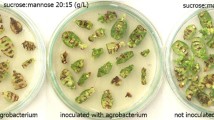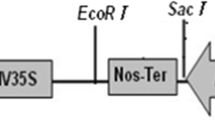Abstract
We compared the transformation frequency of a positive selection system, which employs an Escherichia coli-derived pmi (phosphomannose isomerase) gene as the selectable marker and mannose as the selective agent, to commonly used negative selection systems of bar (phosphinothricin acetyltransferase) /phosphinothricin (PPT), npt II (neomycin phosphotransferase) /G418 (geneticin), and hpt (hygromycin phosphotransferase) /Hygromycin. Transgenic sugarcane plants were obtained following biolistic transformation of callus with four different selectable marker genes. Under different selective agents, transformed callus was selectively proliferated on MS medium containing 13.57 μM of 2,4-D, regenerated on MS medium with 4.44 μM of BA, 9.29 μM of KT, and 0.89 μM of NAA, and rooted on half of MS medium with 13.38 μM of NAA and 0.44 μM of 6-BA. The results demonstrated that the transformation frequency of 4.2% scored in the pmi/mannose positive system was significantly higher than those in the negative selection systems (0.47% for bar/PPT, 1.38% for npt II/G418, and 0.63% for hpt/Hygromycin, respectively). Transgenic sugarcane plants using the pmi/mannose system were confirmed by polymerase chain reaction (PCR) analysis and chlorophenol red (CPR) assay. The CPR assay was found to efficiently and qualitatively detect the transgenic sugarcane from the nontransformed plants because medium color changes in the CPR assay were highly responsive to pmi gene expression and enzyme activity. Thus, a pmi/mannose positive selection system for sugarcane transformation was developed to obviate the use of negative selection systems based on herbicides and antibiotics.





Similar content being viewed by others
References
Arencibia A, Prieto D, Tellez P (1997) Transgenic sugarcane plants resistant to stem borer attack. Mol Breed 3(4):247–255
Arencibia AD, Carmona ER, Tellez P, Chan MT, Yu SM, Trujillo LE, Oramas P (1998) An efficient protocol for sugarcane (Saccharum spp. L.) transformation mediated by Agrobacterium tumefaciens. Transgenic Res 7:213–222
Braga DPV, Arrigoni EDB, Silva-Filho MC, Ulian EC (2003) Expression of the Cry1Ab protein in genetically modified sugarcane for the control of Diatraea saccharalis (Lepidoptera: Crambidae). J New Seeds 5(2–3):209–221
Butterfield M, Irvine J, Valdez-Garza M, Mirkov T (2002) Inheritance and segregation of virus and herbicide resistance transgene in sugarcane. Theor Appl Genet 104(5):797–803
Dale PJ, Clarke B, Fontes MG (2002) Potential for the environmental impact of transgenic crops. Nat Biotechnol 20:567–574
Falco MC, Thulmann Neto A, Ulian EC (2000) Transformation and expression of a gene for herbicide resistance in a Brazilian sugarcane. Plant Cell Rep 19:1188–1194
Gallo-Meagher M, Irvine JE (1996) Herbicide resistant transgenic sugarcane plants containing the bar gene. Crop Sci 36:1367–1374
Gilbert RA, Gallo-Meagher M, Comstock JC, Miler JD, Jain M, Abouzid A (2005) Agronomic evaluation of sugarcane lines transformed for resistance to sugarcane mosaic virus strain E. Crop Sci 45:2060–2067
Gilbert RA, Glynn NC, Comstock JC, Bavis MJ (2009) Agronomic performance and genetic characterization of sugarcane transformed for resistance to sugarcane yellow leaf virus. Field Crop Res 111:39–46
Gill AT, Snyman SJ, Potier BAM, Huckett BI (2004) Towards antibiotic resistance free transgenic sugarcane. Proc S Afr Sug Technol Assess 78:163–166
Goldsworthy A, Street HE (1965) The carbohydrate nutrition of tomato roots VIII. The mechanism of the inhibition by D-mannose of respiration of excised roots. Ann Bot 29:45–58
Guo Y, Ruan M, Yao W, Chen L, Chen R, Zhang M (2008) Difference of coat protein mediated resistance to sugarcane mosaic virus between Badila and Funong 91–4621. J Fujian Agric For Univ (Nat Sci Ed) 37:7–12
Hamerli D, Birch RG (2011) Transgenic expression of trehalulose synthase results in high concentrations of the sucrose isomer trehalulose in mature stems of field-grown sugarcane. Plant Biotechnol J 9:32–37
He Z, Fu Y, Si H, Hu G, Zhang S, Yu Y, Sun Z (2004) Phosphomannose isomerase (pmi) gene as a selectable marker for rice transformation via Agrobacterium. Plant Sci 166:17–22
Herold A, Lewis DH (1977) Mannose and green plants: occurrence, physiology and metabolism, and use as a tool to study the role of orthophosphate. New Phytol 79:1–40
Jain M, Chengalrayan K, Abouzid A, Gallo M (2007) Prospecting the utility of a PMI/mannose selection system for the recovery of transgenic sugarcane (Saccharum spp. hybrid) plants. Plant Cell Rep 26:581–590
Jang JC, León P, Zhou L, Sheen J (1997) Hexokinase as a sugar sensor in higher plants. Plant Cell 9:5–19
Joersbo M, Donaldson I, Kreiberg J, Petersen SG, Brunstedt J, Okkels FT (1998) Analysis of mannose selection used for transformation of sugar beet. Mol Breed 4:111–117
Joyce P, Kuwahata M, Turner N, Lakshmanan P (2010) Selection system and co-cultivation medium are important determinants of Agrobacterium-mediated transformation of sugarcane. Plant Cell Rep 29:173–183
Lakshmanan P, Geijskes RJ, Aitken KS, Grof CPL, Bonnett GD, Smith GR (2005) Sugarcane biotechnology: the challenges and opportunities. In Vitro Cell Dev Biol Plant 41:345–363
Leibbrandt NB, Snyman SJ (2003) Stability of gene expression and agronomic performance of a transgenic herbicide resistant sugarcane line in South Africa. Crop Sci 43(2):671–677
Lucca P, Ye X, Potrykus I (2001) Effective selection and regeneration of transgenic rice plants with mannose as selective agent. Mol Breed 7:43–49
Manickavasagam M, Ganapathi A, Anbazhagan VR (2004) Agrobacterium-mediated genetic transformation and development of herbicide-resistant sugarcane (Saccharum species hybrids) using axillary buds. Plant Cell Rep 23:134–143
McQualter RB, Chong BF, Meyer K, Van-Dyk DE, O'Shea MG, Walton NJ, Viitanen PV, Brumbley SM (2005) Initial evaluation of sugarcane as a production platform for p-hydroxybenzoic acid. Plant Biotechnol J 3:29–41
Mendonca-Hagler L, Souza L, Alexix L, Oda L (2008) Trends in biotechnology and biosafety in Brazil. Environ Biosaf Res 7:115–121
Ming R, Moore PH, Wu KK (2006) Sugarcane improvement through breeding and biotechnology. Plant Breed Rev 27:115–118
Molinari HBC, Marura CJ, Daros E, de Camposa MKF, de Carvalhoa JFRP, Bespalhok Filho JC, Pereira LFP, Vieira LGE (2007) Evaluation of the stress-inducible production of proline in transgenic sugarcane (Saccharum spp.): osmotic adjustment, chlorophyll fluorescence and oxidative stress. Physiol Plant 130:218–229
Nielsen KM, Bones AM, Smalla K, Van Elsas JD (1998) Horizontal gene transfer from transgenic plants to terrestrial bacteria—a rare event? FEMS Microbiol Rev 22:79–103
Pego JV, Weisbeek PJ, Smeekens SCM (1999) Mannose inhibits Arabidopsis germination via a hexokinase-mediated step. Plant Physiol 119:1017–1023
Porebski S, Bailey LG, Baum BR (1997) Modification of a CTAB DNA extraction protocol for plants containing high polysaccharides and polyphenol component. Plant Mol Biol Rep 15:8–15
Privalle LS (2002) Phosphomannose isomerase, a novel plant selection system: potential allergenicity assessment. Ann NY Acad Sci 964:129–138
Reed J, Privalle L, Powell ML, Meghji M, Dawson J, Dunder E, Suttie J, Wenck A, Launis K, Kramer C, Chang YF, Hansen G, Wright M (2001) Phosphomannose isomerase: an efficient selectable marker for plant transformation. In Vitro Cell Develop Biol Plant 37:127–132
Singh RK, Kumar P, Tiwari NN, Rastogi J, Singh SP (2013) Current status of sugarcane transgenic: an overview. Adv Genet Eng 2:112. doi:10.4172/2169-0111.1000112
Suprasanna P, Manjunatha BR, Bapat VA (2008) Mannose-based selection with phosphomannose-isomerase (PMI) gene as a positive selectable marker for rice genetic transformation. J Crop Sci Biotechnol 11:233–236
Vickers JE, Grof CPL, Bonnett GD, Jackson PA, Knight DP, Roberts SE, Robinson SP (2005) Overexpression of polyphenol oxidase in transgenic sugarcane results in darker juice and raw sugar. Crop Sci 45:354–362
Wang AS, Evans RA, Altendorf PR, Hanten JA, Doyle MC, Rosichan JL (2000) A mannose selection system for production of fertile transgenic maize plants from protoplasts. Plant Cell Rep 19:654–660
Wilmink A, Dons JJM (1993) Selective agents and marker genes for use in transformation of monocotyledonous plants. Plant Mol Biol Rep 11:165–185
World Sugar Statistics (2011) F.O. Licht’s world sugar year book, 72nd edition. Informa
Wright M, Dawson J, Dunder E, Suttie J, Reed J, Kramer C, Chang Y, Novitzky R, Wang H, Moore LA (2001) Efficient biolistic transformation of maize (Zea mays L.) and wheat (Triticum aestivum L.) using the phosphomannose isomerase gene, pmi, as the selectable marker. Plant Cell Rep 20:429–436
Wu L, Birch RG (2010) Physiological basis for enhanced sucrose accumulation in an engineered sugarcane cell line. Funct Plant Biol 37:1161–1174
Zhang MQ, Rao GP, Gaur RK, Ruan MH, Singh M, Sharma SR, Singh A and Singh P (2006) Sugarcane mosaic disease in Characterization, Diagnosis & Management of Plant Virus (Vol. 1: Industrial Crops) In: Rao GP, Paul khurama SM, Lenardom SL (eds) Studium Press, Texas, USA, pp111-144
Zhu YJ, McCafferty H, Osterman G, Lim S, Agbayani R, Lehrer A, Scheck S, Komor E (2010) Genetic transformation with untranslatable coat protein gene of sugarcane yellow leaf virus reduces virus titers in sugarcane. Transgenic Res 1:1–10
Acknowledgments
The authors are grateful to Dr. Jack C. Comstock (plant pathologist of Sugarcane Field Station at Canal Point, USDA-ARS), Dr. Yi Li (Professor of Plant Biotechnology, University of Connecticut), and Dr. Christopher Brooks (Bioscience Editing Solutions) for critically reading this paper and providing helpful suggestions. Financial support was provided by the National High Technology Research and Development Program of China (project 2008AA10Z114), Guangxi Natural Science Foundation (project 2014GXNSFFA118002) and Guangxi special funding for distinguished experts.
Conflict of interest
The authors have declared no conflict of interest.
Author information
Authors and Affiliations
Corresponding author
Additional information
Editor: John Forster
Rights and permissions
About this article
Cite this article
Zhang, M., Zhuo, X., Wang, J. et al. Effective selection and regeneration of transgenic sugarcane plants using positive selection system. In Vitro Cell.Dev.Biol.-Plant 51, 52–61 (2015). https://doi.org/10.1007/s11627-014-9644-y
Received:
Accepted:
Published:
Issue Date:
DOI: https://doi.org/10.1007/s11627-014-9644-y




